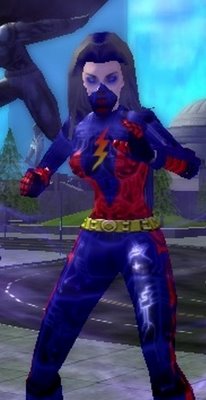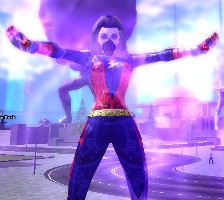
My inhibitions no longer being lowered by alcohol I am now free to dispense with the mildly embarrassing comments on my personal life, and kick the geek up a notch for this post. I’ve been talking about it long enough here is the dreaded post about City of Heroes. What is prompting this post is the fact that two fairly momentous events (momentous events at least within the context of the game) have occurred within the last few days. I had a character reach 14th, and then 15th level.
Before I can describe why this is so cool, I really need to explain some basics of the game. First City of Heroes is an example of what is know as a MMORPG a rather impressive looking acronym that stands for Massively-Multiplayer Online Role-Playing Game. If you need an explanation of what that is, and don’t feel like following the link I provided then let me say this; the name is pretty self-explanatory. Massively-multiplayer as in lots and lots of people playing at the same time; World of Warcraft, one of the most popular MMORGPs has something in the neighborhood of 6 million subscribers worldwide, now naturally not all of them will be playing at the exact same time, but even a small percentage of 6 million is a pretty big number (1% alone is 60,000 people). Online as in it happens over the Internet. Role-playing game as in it’s a game where you pretend to be somebody else. In City of Heroes you play the role of a superhero defending Paragon City from crime and the forces of evil.
The first two things you do when creating a new hero are decide on the archetype and origin of the hero. There are five basic archetypes: blasters, controllers, defenders, scrappers, and tankers. The archetypes define in broad strokes what type of hero you are creating by determining what your primary and secondary power categories are, whether your hit points will be low, medium, or high, and whether your damage output will be low, medium, or high. Blasters for example have low hit points, but high damage output, and as the name implies their primary power focus are ranged attacks (think for example of The Fantastic Four’s The Human Torch). On the other hand you have the melee archetypes scrappers and tankers. They lack ranged attacks, but excel at getting up-close-and-personal with their foes, however each type goes about that in a different way. Scrappers have high damage, medium hit points, their primary power category is melee, and their secondary power category is defense (think Wolverine). While tankers have medium damage, high hit points, the primary power category of defense, and the secondary power category of melee (think The Thing from the Fantastic Four). So a scrapper can deal out more damage in a fight, but cannot last as long as a tanker who can soak up more damage because the archetype will take less damage per attack, and will have more hit points in the first place. Within each archetype there are numerous different power sets so one blaster could focus on fire attacks, while another could be an archer.
Origins determine how characters received their powers. There are also five types of origins: magic, mutation, natural, science, and technology. Magic heroes gained their powers from the mystic realms (Dr. Strange or Wonder Girl). Mutation heroes were born with their powers (the X-Men). Natural heroes derive their powers from either training (Batman), or their powers are the natural inborn traits of their species (The Martian Manhunter or Superman). The powers of science heroes are the results of either scientific experimentation (Captain America), or an a fortuitous accident (Spider-Man or The Fantastic Four). Technology heroes derive their powers from devices (the Green Lantern or Iron Man). To some extent origins exist mainly for flavor, as they have no effect on what powers can be selected or how those powers work, but origins do effect which NPC contacts a hero will start with, and what types of equipment can be used to improve the character. Origins also grant each hero a ranged attack (albeit a fairly short range) that does very minor damage, and has a possible secondary effect that varies by origin.
Once archetype and origin are out of the way the primary and secondary power sets are chosen. First the primary power set is chosen. Blasters for example can chose between archery, assault rifle, electric blast, energy blast, ice blast, fire blast, and sonic attack for their primary power set. Each set then has a list of nine powers tied together by a common theme that as the characters advance in level the more advanced powers on the list will become available to them. The first two available powers in the archery set are snap shot, and aimed shot with their difference being snap shot does less damage, but recharges more quickly then aimed shot. A starting blaster using the archery power set would be able to choose one of those two powers at first level.
Then the secondary power set is chosen. There can be some overlap between archetypes on power sets. For example the defender has ranged attacks as a secondary power category so can choose some of the same power sets as the blaster, but not all of them, and has access to some ranged power sets that the blaster doesn’t. In other cases there is little to no overlap scrappers and tankers both have access to the melee and defense power categories (differing in which category each archetype has as primary and secondary), but they share only one power set in common in their respective defense category, and no power sets in common in their respective melee category.
Even when different archetypes have power sets in common the archetype that has that power set as a primary power will always be more effective then the archetype that has the power set as a secondary power assuming the two characters are the same level (or really within a level of each other). A blaster using archery powers will always do more damage then a defender of the same level using archer powers. As another example defenders who select one of the power sets that grant healing powers will always heal more hit points of damage per use, then a controller of the same level using the same power set because for the controller it will be a secondary power while for the defender it will be a primary power. Another difference between primary and secondary power sets is the speed at which the powers on the set become available to the characters. As a character goes up in level the more advanced powers on the primary set become available at a lower level then the more advanced powers on the secondary set. Sticking with defenders and controllers for an example a defender using the empathy power set will be able to select the power resurrection (being able to bring defeated heroes back to life is a popular power when heroes team up) as early as 6th level which is when the forth power on a primary power list becomes available to characters. A controller with empathy as a secondary power set won’t be able to choose resurrection as a power until 10th level, because that is the level a character has to before the 4th power on the secondary power list is available.
In any event starting heroes are only able to chose the first power available on their secondary power set, so a defender who selected archery as the secondary power could only take snap shot at first level. Armed with those two powers one primary and one secondary, along with the inherent power of brawl (any hero regardless of archetype can punch somebody), and the minor power granted by the chosen origin the hero is now ready for combating evil. Actually character creation continues on to what may be my favorite part - costume design, and then wraps up with selecting a name and the optional writing of a description (usually of the characters origin), but that doesn’t really factor into why I’m writing this post so I’ll move on.
As a character goes up in level different things happen. There is the obvious (at least to anyone who’s ever played a RPG) the character gets more hit points, and does more damage, and at 2nd level and every two levels after that the character can select one new power from their list of available powers drawn from their primary and secondary power lists. There is another often highly anticipated event that happens at 6th level. At that level charactesr can start selecting powers from the pool power sets. The pool power sets each contain four powers the first two of which are available to be selected by any hero regardless of archetype as long as they are at least 6th level. The third power in each pool can be selected at 14th level (or later) as long as the hero as previously selected at least one of the first two powers in the pool, and the fourth power in the pool in the set can be selected at 20th level (or later) as long as the character has selected the third power in the pool at an earlier level.
The idea behind these pool powers are there are some abilities any hero should be able to pursue if desired (the power sets are optional and don’t have to be selected). Among these power pools are the four travel powers flight, leaping, speed, and teleportation. The first two powers in each of these four pools are all pretty interesting. The true gems, however, that most people want their characters to have at least one of all happen to be the third powers on the respective lists. Those coveted powers are fly, super jump, super speed, and teleport. Each one of these powers allows the character go get around Paragon City very quickly. As implied by the name MMORPG (or at least the first M) Paragon City is a pretty big place and it can take a while moving your character from one location to another (a not uncommon complaint in MMORPGs) especially when the area you have to travel through is filled with numerous villains of a higher level then your character. Once one of these travel powers is obtained much of difficulty (and time spent) in moving from place to place is removed.
This of course is the first cool thing I mentioned that happened to one of my characters recently. I have an electricity blaster named The Sparkstress (pictured above) who as of 14th level has super speed. It rocks. I absolutely love watching her zip across maps in about 30 seconds that would have taken a few minutes to cross before (and that is before factoring in additional delays caused by running into groups of villains). The second cool thing that happened at 15th level is I got to select a title for The Sparkstress. So she now displays to all the other players as The Extraordinary Sparkstress (in retrospect I kind of wish I’d opted for startling because The Startling Sparkstress would have been pretty damn cool).
Okay that’s probably enough about City of Heroes for the time being. I likely will have more to say about the game in the future. However before I go I do have a chess update for you. I have received a move from Erik, and remarkably responded to it with in 24 hours. Erik was no doubt extremely shocked.
29. a4 Kd6
30. Bb3
I'll leave you with one final picture of The Extraordinary Sparkstress.
No comments:
Post a Comment